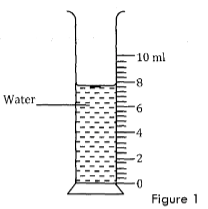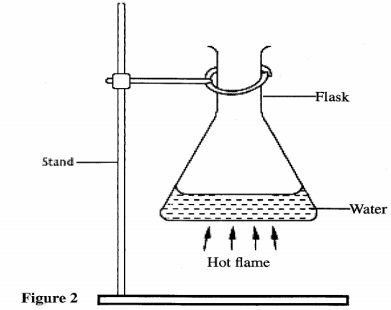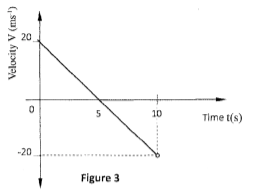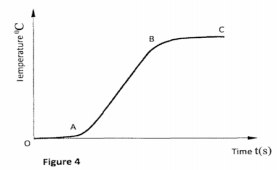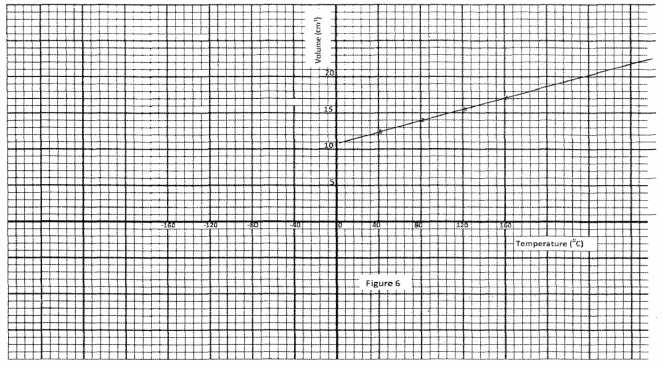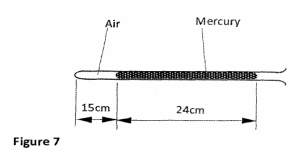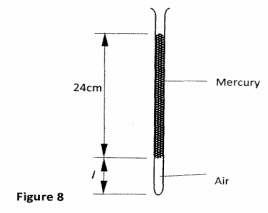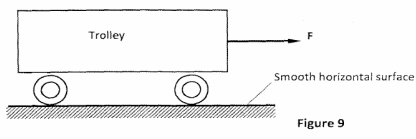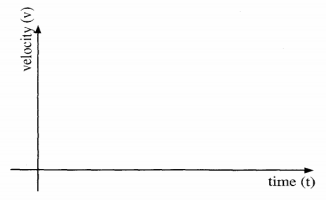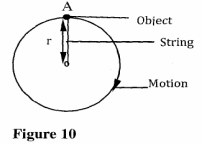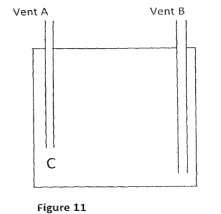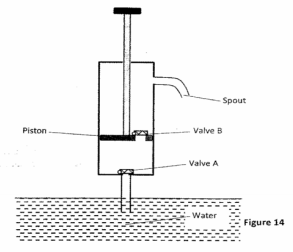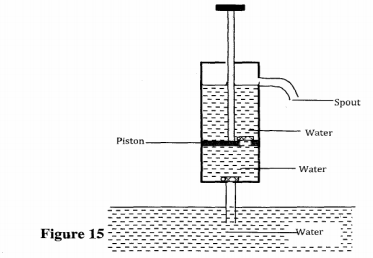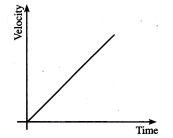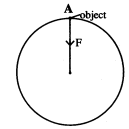SECTION A (25 marks)
Answer all the questions in this section in the spaces provided.
- Figure 1 shows a measuring cylinder containing some water.
Determine the reading on the measuring cylinder, after three drops of water each volume 0.6 cm3 are added. (2 marks) - A student pulls a block of wood along a horizontal surface by applying a constant force. State the reason why the block moves at a constant velocity. (1 mark)
- A solid weighs 16.5 N on the surface of the moon. The force of gravity on the moon is 1.7Nkg-1. Determine the mass of the solid. (3 marks)
- A bottle containing a smelling gas is opened at the front of a classroom. State the reason why the gas is detected throughout the room. (1 mark)
- Figure 2 shows a flat bottomed flask containing some water. It is heated directly with a very hot flame.
Explain why the flask is likely to crack. (2 marks) - State six environmental hazards that may occur when oil spills over a large surface area of the sea. (2 marks)
- A balloon is filled with a gas which is lighter than air. It is observed to rise in air upto a certain height. State a reason why the balloon stops rising. (1 mark)
- In verifying the pressure law of gases, the temperature and pressure of a gas are varied at constant volume. State the conditions necessary for the law to hold. (1 mark)
- State the reason why a steel sphere resting on a horizontal surface said to be in neutral equilibrium. (1 mark)
- Table 1 shows the results of an experiment carried out to study the properties of a spring.
Table 1
State with a reason whether the experiment was done within the elastic limit of the spring. (2 marks)Force (N) 0 10 20 30 40 Extension (cm) 0 2 4 6 8 - Figure 3 shows a graph of velocity against time for a moving body.
Describe the motion of the body during the 10 seconds. (2 marks) - State two reasons why the efficiency of a pulley system is always less than 100%. (2 marks)
- Figure 4 shows a graph of temperature against time when melting pure ice at 00C is heated uniformly.
Explain what happens between parts;- OA: ………………………………………………….(1 mark)
- AB. …………………………………………………(1 mark)
-
- An aeroplane is moving horizontally through still air at a uniform speed. It is observed that when the speed of the plane is increased, its height above the ground increases. State the reason for this observation. (1 mark)
- Figure 5 shows parts A, B and C of a glass tube.
State with a reason the part of the tube in which the pressure will be lowest when air is blown through the tube from A towards C. (2 marks)
SECTION B (55 marks)
Answer all the questions in this section in the spaces provided.
- An aeroplane is moving horizontally through still air at a uniform speed. It is observed that when the speed of the plane is increased, its height above the ground increases. State the reason for this observation. (1 mark)
-
- Figure 6 shows a graph of volume against temperature for a given gas.
Use the graph to determine the absolute zero temperature in 0C. (2 marks) - Figure 7 shows a horizontal tube containing air trapped by a mercury thread of length 24 cm. The length of the closed air column is 15 cm. The atmospheric pressure is 76 cm Hg.
- State the pressure of the enclosed air. (1 mark)
- The tube is now held in a vertical position with the open end facing upwards as shown in figure 8.
Determine:- The pressure of the enclosed air. (1 mark)
- The length l of the enclosed air column. (3 marks)
- In an experiment to demonstrate atmospheric pressure, a plastic bottle is partially filled with hot water and the bottle is then tightly corked. After sometime the bottle starts to get deformed.
- State the purpose of the hot water. (1 mark)
- State the reason why the bottle gets deformed. (1 mark)
- Explain your answer in c (ii) (2 marks)
- Figure 6 shows a graph of volume against temperature for a given gas.
-
- Figure 9 shows a trolley on a smooth surface being pulled by a constant force F.
- On the axis provided, sketch the velocity-time graph for the motion of the trolley. (2 marks)
- A parachute falling through the air attains terminal velocity after a short-time.
State the reason why it attains terminal velocity. (1 mark)
- On the axis provided, sketch the velocity-time graph for the motion of the trolley. (2 marks)
- A ball of mass 200 g is thrown vertically upwards with velocity of 5 ms-1. The air resistance is 0.4 N.
Determine:- The net force of the ball as it moves up;
(take acceleration due to gravity g =10 ms-2) (2 marks) - The acceleration of the ball. (3 marks)
- The maximum height reached by the ball. (3 marks)
- The net force of the ball as it moves up;
- Figure 10 shows the path of an object of mass m attached to a string of a length r when whirled in a vertical circle at a constant speed V. A is at the highest point on its path.
- State the forces that provide the centripetal force on the object when it is at point A. (2 marks)
- Indicate with an arrow on the diagram the direction of the net force F acting on the object when it is at A. (1 mark)
- Figure 9 shows a trolley on a smooth surface being pulled by a constant force F.
-
- Figure 11 shows how an underground room was ventilated. It had two vents, one at A and the other at B. A fire was lit at point C.
Explain what happened to the ventilation when the fire was lit. (3 marks) - Explain how a vaccum flask minimizes loss of heat through radiation. (1 mark)
- In an experiment to determine the unusual expansion of water, a fixed mass of water at 00C was heated until its temperature reached 200C. On the axis provided, sketch a graph of density against temperature of the water. From 00C to 200C. (2 marks)
- An immersion heater rated 2.5 kW is immersed into a plastic jug containing 2 kg of water and switched on for four minutes. Determine:
- The quantity of heat gained by the water; (2 marks)
- The temperature change of the water. (3 marks) (take specific heat capacity of water as 4.2 × 103 Jkg-1 K-1)
- Figure 11 shows how an underground room was ventilated. It had two vents, one at A and the other at B. A fire was lit at point C.
-
- Figure 12 shows a set up used to determine the mass of a solid S. The rod is pivoted at its centre of gravity C.
- Name two measurements that need to be made to determine the mass of solid S. (1 mark)
- Write an expression to show how the measurement in (i) above are used to obtain the mass of S. (2 marks)
- Figure 13 shows a log of wood of mass 20 kg submerged in water in a pond and held in position by a string fixed to the bottom of the pond.
Given that the density of water is 1000 kgm-3 and that of wood is 800 kgm-3, determine the:- The volume of the log. (3 marks)
- Upthrust of the log. (2 marks)
- Tension in the string. (2 marks)
- Figure 12 shows a set up used to determine the mass of a solid S. The rod is pivoted at its centre of gravity C.
-
- Figure 14 shows a lift pump.
Explain why, when the piston is:- Pulled upwards, valve A opens while valve B closes. (2 marks)
- Pushed downwards, valve A closes while valve B opens. (2 marks)
- After several strokes, water rises above the piston as shown in figure 15.
State how water is removed from the cylinder through the spout. (1 mark) - A lift pump can lift water to a maximum height of 10 m. Determine the maximum height to which the pump can raise paraffin.
(take density of paraffin 800 kgm-3 and density of water as 1000 kgm-3). - State one factor that determines the height to which a force pump can lift water. (1 mark)
- Figure 14 shows a lift pump.

MARKING SCHEME
- 7.6+(0.6x3);
7.6+1.8
9.4ml; (2 marks) - Frictional force is equal to the applied force but in the opposite direction, hence the net applied force is zero; (1 mark)
- m= w/g;
=16.5
1.7
=9.71kg; (3 marks) - The gas diffuses; from the region of higher concentration to a region of low concentration. (1 mark)
- Glass is a poor conductor, unequal expansion leads to cracking; (2 marks)
- Oil film spreads over a large surface of the sea reducing inflow of air needed by the aquatic life;
- Reduces the light entering
- Beaches become dirty;
- Poisons marine animals when taken in; (any two correct) (2 marks)
- Stop rising when upthrust is equal to the weight of the balloon and its contents; (1 mark)
- Mass of gas must be constant; (1 mark)
-
- The height of it's centre of gravity above the surface is constant;
- Position of its center of gravity does not change. (1 mark)
- It is within the elastic limit; because
- the values of F/e = constant in all the cases F/e = 5
OR - a graph of force against extension is straight line through the origin;
- conclusion from graph;
(2 marks)
- the values of F/e = constant in all the cases F/e = 5
- The body's velocity decreases uniformly from 20m/s and becomes zero after 5 seconds: the velocity then starts increasing in the opposite direction to a maximum value of 20m/s. (2 marks)
-
- Friction between the moving parts of the pulley system;
- Work done against friction;
- Work done lifting the moving parts of the pulley system;
(2 marks)
-
- OA - heat gained is breaking intermolecular forces of the molecules/melt the ice without change in temperature;
- AB-temperature of the water formed starts to rise until it starts to boil;
(2 marks)
-
- Air above the plane moves faster than air below it (because of it's shape) creating a region of low pressure above the place hence plane experiences a lift, due to the pressure difference. (1 mark)
- At B; because the cross-sectional area is smaller hence the air moves faster in that region;
(2 marks)
SECTION B
-
- Extrapolation of graph to cut the temperature axis;
absolute zero = 278 ± 2°c; (-272 ± 2°c to -280° ± 2°c; (2 marks) -
- When tube is horizontal pressure of air is equal to atmospheric pressure; i.e. 76cmHg.
(1 mark) -
- When vertical,
pressure of air = pressure due to mercury column+atmospheric pressure
= (24+76)cmHg
= 100cmHg; (1 mark) - PV = a constant;
- 76x15=(76+24)l;
l = 76 x 15
100
= 11.4cm; (3 marks)
- When vertical,
- When tube is horizontal pressure of air is equal to atmospheric pressure; i.e. 76cmHg.
-
- To expel air; (1 mark)
- Pressure of air outside the bottle is greater than the pressure of air inside; (1 mark)
- Cooling causes condensation of vapour;
Creating a partial vacuum; (2 marks)
- Extrapolation of graph to cut the temperature axis;
-
-
-
(straight line not necessarily through the origin but with positive gradient)
acceleration;
constant acceleration;
(2 marks) - Net force on the parachute becomes zero. (Sum of downward forces on it should be equal to sum of upward forces) (1 mark)
-
-
- Net force = 2+0.4; = 2.4N; (2 marks)
- F=ma; 2.4 = 0.2a+;
a = −12ms2; (3 marks) - V2 = u2 + 2as;
s = 0−52
−2x12
≃ 1.04m; (3 marks)
-
-
- Weight of object;
- Tension in the string;
(2 marks)
-
The force should be from point A to the center but not beyond (1 mark)
-
-
-
-
- Fire heats air around region C which expands and becomes less dense;
- The less dense air rises up the vent and emerges at A;
- Cool (more dense) air moves down the vent at B introducing fresh air into the mine
(3 marks)
- The flask has double walls which are silverly on both sides the shiny surface is a good reflector of heat; (1 mark)
-
(1 mark)
-
- Heat gained by water = power x time;
= 2.5x103 x 4x60;
= 6.0x105J; (3 marks) - E=mc∆θ;
∆θ = 2.5 x 4 x 60 x 103
2 x 4.2 x 103
= 71.43°C;
(3 marks)
- Heat gained by water = power x time;
-
-
-
- Lengths BC and CD;
- 100 x BC = S x CD;
S = 100BC
CD (2 marks)
-
- Volume of 10g = mass
density
=20/800
= 2.5x 10−2m3; (3 marks) - Upthrust = weight of water displaced
= 20 x 100 x 10;
800
= 2.5 x 102N; (2 marks) - Tension = U−mg;
= 250 − 200
= 50N;
- Volume of 10g = mass
-
-
-
- Valve B rests under its own weight;
- pressure in the cylinder decreases and water rises into the cylinder pushing the valve open; (2 marks)
- Valve A rests under its own weight and the weight of the water; high pressure is created in the region between valve A and valve B forcing valve B to open; (1 mark)
- Valve B rests under its own weight;
- The water is lifted up by the piston ad comes out through the spout; (1 mark)
- Pwghw = Ppghp;
hp = 1000 x 10.
800
=12.5m; (3 marks) -
- Force applied on piston (during downstroke);
- Ability of the parts of the pump to withstand the pressure of the liquid column;
(2 marks)
-
Download KCSE 2012 Physics Paper 1 with Marking Scheme.
Tap Here to Download for 50/-
Get on WhatsApp for 50/-
Why download?
- ✔ To read offline at any time.
- ✔ To Print at your convenience
- ✔ Share Easily with Friends / Students

